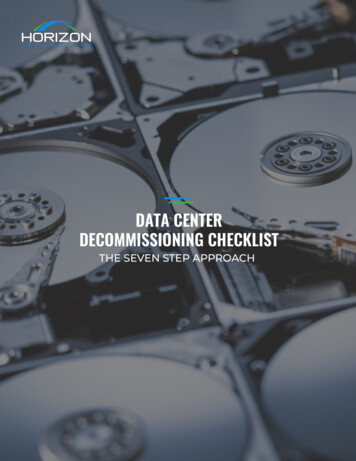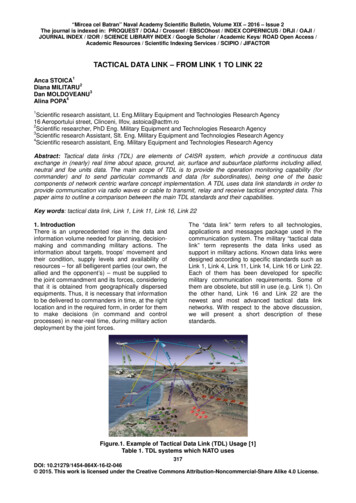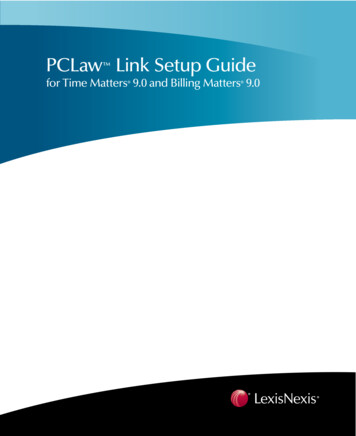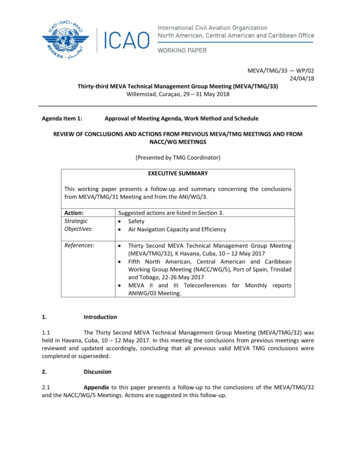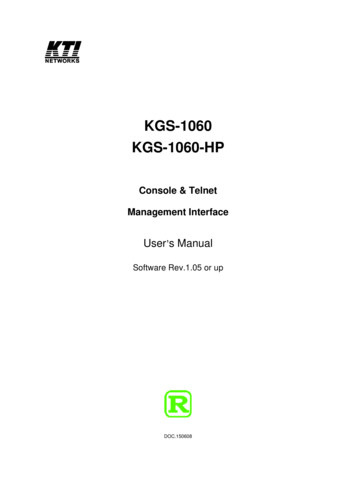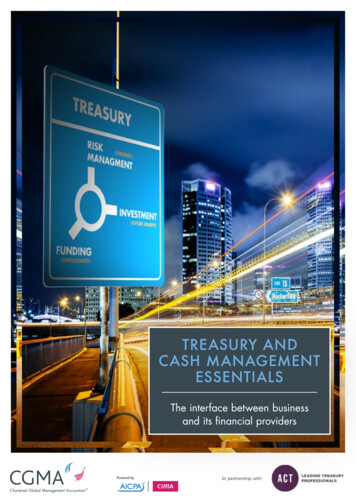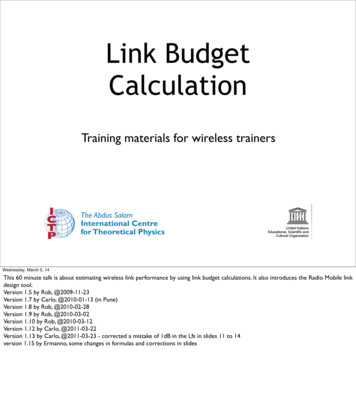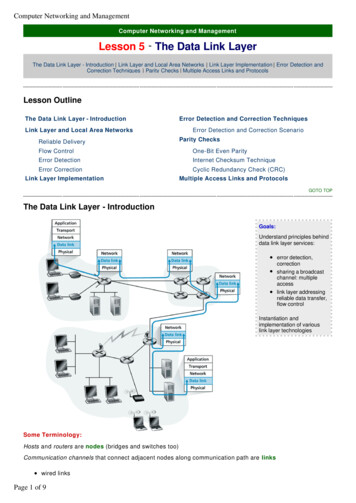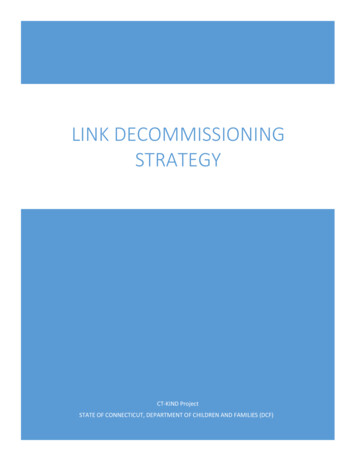
Transcription
LINK DECOMMISSIONINGSTRATEGYCT-KIND ProjectSTATE OF CONNECTICUT, DEPARTMENT OF CHILDREN AND FAMILIES (DCF)
ContentsOverview . 3Background . 3Strangler Pattern . 3Goals . 3Minimize Change to Monolith . 4Minimize Creating More Dependencies . 5Create Business Defined Strangler Scope . 5Replacement Strategy . 5Methodologies/Tools . 6Enterprise Service Bus (ESB) . 6What is ESB?. 6What problems does ESB solve? Why use ESB? . 6What is guaranteed message delivery? How does it work? . 6How can the ESB be used to solve our conversion/migration needs? . 7Extract Transform Load (ETL) . 7What is ETL? . 7What are some ETL tools that we can use? . 8How do you identify the data to be converted and loaded into CT-KIND? . 8Just because it can be converted doesn’t necessarily mean it should? . 8How do you handle the differences between the data models? . 9Robotic Process Automation (RPA). 9What is RPA? . 9How can this technology help us? . 9Security . 9What is the role of security in the migration strategy? . 9PowerBuilder Web Services . 11What are web services? REST vs SOAP? What are PowerBuilder specific web services? . 11What is SOAP? When to use SOAP?. 11How can we rip out the business logic from PowerBuilder and make a SOAP service that can helpour Migration Strategy? . 11LINK Code Conversion . 12
Sections . 12Batch Process . 12Master Data Management (MDM) . 13
OverviewBackgroundThe Department of Children and Families (DCF) is replacing their current child welfare system, LINK, withCT-KIND (Kid’s Information Network Database) to comply with the Federal Comprehensive Child WelfareInformation System (CCWIS) regulations, and promote efficiency and streamline processes in practice.This revamp is a fresh start as it is a complete redesign leveraging the newest technologies to meet theneeds of the staff and the families served based on updated business workflows that have been througha LEAN process. The LEAN process ensures that the work performed is as efficient as possible, and theprocess is updated per any legislative or policy changes. By basing this rewrite effort on updatedworkflow processes, we are making sure we are cutting out steps that are part of the current processthat do not bring business value.In order to reduce the risk of developing such a large solution covering many areas of child welfare andcomply with the Federal requirements, DCF is developing the new system in modules, one module at atime through Agile Development, using the SAFe methodology. This will allow DCF to deliver value toour customers quicker and incrementally, and to course correct if needed. It allows DCF to tackle thecomplexities of converting parts of LINK , minimizing the risk. By doing development modularly with theassistance of a vendor pool, it allows DCF to build in competition amongst vendors to deliver a qualityproduct, and also allows DCF the flexibility to switch vendors if they are underperforming.Because of the requirements mentioned above, and because of all the benefits of Agile Development, anatural question arises. How do we do development modularly? and, How do we ensure we developeach module individually and ensure the rest of LINK continues to function?Strangler PatternWhat is the Strangler Pattern? The idea of the Strangler Pattern is to incrementally migrate themonolith by replacing pieces of functionality gradually until eventually, all of the monolith is replaced.As each functionality is replaced, the monolith is “strangled” allowing it to be decommissioned.GoalsWith the following strategy, DCF will be attempting to convert LINK from a set of older technologies tonewer technologies. Because of the inherit risk of converting a large legacy system, we need to adhereto a set of values which will minimize the risk of the conversion. DCF’s existing legacy system, LINK, iscomprised of the following technologies:
LINK (written in PowerBuilder)DB2Batch (Cobol on mainframe)Web Applications (asp/asp.net/extjs/c#)SQL ServerCT-KIND will be built on the following technologies: Microsoft Dynamics 365 (on premise)SQL Server/SSISBizTalk Server 2016SharePoint 2016MDM VisionWareMicrosoft Exchange IntegrationSSRSMicroFocus UFTStress StimulusPowerBIID.MERSA.NET/ Javscript/EXTJSMinimize Change to MonolithIn many legacy strategies that are described in the industry, there is the reference to the legacy systemas the monolith, a term believed to come from other industries and could have different meanings.However, for the sake of this strategy, we will refer to it interchangeably as the monolith or simplyLegacy to describe all the systems that make up the legacy application.Here are some of the disadvantages and advantages of a legacy system:Disadvantages: Difficult to understand system functionalitiesHard to find and separate business logic from User Interface and Data AccessNo documentationDifficult to integrate with current systemsHard to enhance or modify because unit tests, regressions tests are not availableAdvantages: Able to support existing business processes.Since the monolith is a very large, complex system with many different pieces to it, it will be verydifficult, nearly impossible to make changes to its data model or database, or modify its processes.Therefore, one of DCF’s values would be to avoid the tendency to change or modify the existingdatabase model.
The goal is to replace the monolith, not to keep adding to it. Every additional piece of code, even tosupport the conversion process, builds additional dependencies on legacy code. Therefore, in order tominimize risk, DCF needs to avoid the tendency to write new functionality as part of the monolith,unless absolutely necessary.Minimize Creating More DependenciesWhere DCF needs to write code as part of the monolith, it should be done in such a way in whichadditional dependencies are not built on the monolith if possible. So, another one of our values wouldbe to not build additional dependencies.Create Business Defined Strangler ScopeAdditional planning will be needed to determine how to apply the Strangler Pattern for DCF with our setof technologies and the requirement to keep the monolith running. In particular, the risk is high whenthe monolith is not built using an API, has no easy way to intercept database calls, or when the code iscomplex and the business logic, data access, and GUI layers are intermingled and intertwined. In orderto minimize this risk, DCF needs to strangle a vertical slice across all layers at a time. The vertical sliceshould include everything required to perform the business workflow function end to end. The verticalslice is defined to include all the layers required to define a particular workflow scope: User InterfaceBusiness RulesServiceDatabase LogicSecurityReportingTherefore, the value is to keep the scope of replacement at the “complete business workflow scope”keeping in mind the following: Minimize Legacy Database Model ChangesMinimize Legacy Code AdditionsSingle Business Process ScopeReplacement StrategyPlanning will be needed in order to determine the steps in the replacement strategy such as:1. Impact Analyses for each process to identify the scope2. Identify Data Conversion Scope3. Identify User Impacts and security Permissions
4. Identity Methodology Technology or tools being used to implement the replacementfunctionalityMethodologies/ToolsIn order to achieve our goal we have to rely on the strengths of a multitude of technologies. Oftentimes there are multiple ways to achieve and deliver a business goal and value to the client. Howevereach time we replace a piece of functionality with new methodologies and tools, we must make a bestcase effort to do cost-benefit analysis, and pick the Methodologies and Tools that have the best longterm benefit and outcome. Some of the technologies part of our “tool belt” which make up what isknown as the “Technology Stack” are listed below with insight how those tools can help achieve goalsand solve problems.Enterprise Service Bus (ESB)What is ESB?BizTalk ESB is an Enterprise Service Bus (ESB) used for message-based communication betweendisparate software systems for Enterprise Application Integration (EAI). EAI is based on a set of rulesand principles for integrating application together over a bus-like infrastructure. Different applicationscan be integrated by putting a communication bus between them to enable the application to talk to theenterprise bus and vice versa. The ESB bus decouples the application from each other.What problems does ESB solve? Why use ESB?It is inevitable that LINK and CT-KIND need to communicate to achieve their functional goals during thestrangler period. During the strangler period, both systems should make minimum, directdependencies. BizTalk ESB abstracts direct dependencies between the systems by acting as a middlelayer. Decoupling the dependencies is achieved by performing the data mapping, transformation anddata delivery between LINK and CT-KIND. BizTalk ESB provides content-based delivery of messagesbased on the source data to the target system such as SQL or DB2. During the process ofrouting/delivery, source data undergoes transformation within the ESB mapping layer, as required forthe target systems (SQL or DB2) based on business rules depicted in the ESB. ESB achieves routing ofthe source data to multiple target system based on target subscriptions to the intended source messagedata.What is guaranteed message delivery? How does it work?Messages and message subscriptions are stored in the BizTalk SQL database. The messages arepersisted in DB until all the subscribers consume the source message. If the message is failed to deliverto the target system, BizTalk ESB retries the message delivery. If the target fails even after the retry,failed messages are routed and collected for error notification. Failed process/messages are hydrated inBizTalk SQL and can be resumed (mostly) from the point where it failed by using resume functionalityassociated with orchestration and message processing. This ensures guaranteed message deliver.
BizTalk ESB uses alternate delivery mechanisms if the delivery is failed with the primary target, as it willthen send the data to the secondary using a backup transport. This ensures guaranteed messagedelivery.How can the ESB be used to solve our conversion/migration needs? BizTalk ESB detecting data changes on SQL or DB2Support for SQL and DB2 out of the box adaptersSupport for security and reliable data deliverySSO based data deliveryData mapping based on static data mappingDynamic data mapping based on the content of the dataTransformation of the data using XSLTDelivering data to both SQL and DB2Distributed transaction between SQL and DB2 databaseAbstracting the workflow process for the EAI at the orchestration layerDynamic routing of messages based on itineraryHandling the batch or real time processingError and exception of failed data transfersReal time scaling and BizTalk throttlingHigh availability and disaster recoverExtract Transform Load (ETL)What is ETL?Extract Transform Load (ETL) is a process for moving or copying data from one data source to another,such as copying existing data from the legacy LINK database into the CT-KIND database, or copyingnew/updated data from CT-KIND back to LINK. This process allows for data to be available forfunctionality that exists only in LINK (because it has not yet been implemented in CT-KIND). It istypically, though not exclusively, used in data warehouse applications, where data from multiple anddisparate sources are brought together into a common structure to be analyzed, or processed together.“ETL” stands for the three separate steps involved in the process: “extract”, “transform” and“load.” The extract step of the process is where selected data is pulled from the source database. Theremay be business rules established to define exactly which data is extracted from the source database,such as data that has been created and/or updated since the last synchronization of the target database.The data is then manipulated, or transformed, via a set of business rules so that it will conform to thenew target database design/structure. An example of a transformation might be a case where sex code(i.e.: male or female) is stored as “1” (male) or “2” (female) in the source database, but it is stored as“M” or “F” in the target database. The transformation step will convert all “1”s to “M”, and all “2”s to“F.”. Another kind of transformation might be a derivation in which data from the source database iscalculated into a completely new field, which is then stored on the target database. An example of aderivation might be in a retail sales database which stores “quantity sold” and “unit price” for items, but
your target database only stores the “sale amount” for an item. The transformation would calculate“sale amt qty sold * unit price” and only store the calculated sale amount value in the targetdatabase.Finally, the extracted and transformed data is then loaded into the target database. The structure of thetarget database may be very different from the source, so this would be handled by both the transformand load steps. For instance, data about people may be stored in one table in the source database, butit may be stored in three related tables in the target database. The transformation and load steps wouldsplit the data up appropriately so that it is stored in the target database in the correct tables with thecorrect relationships to connect the data together.What are some ETL tools that we can use?There are a number of different ETL tools available on the market, such as “SSIS” (which is integratedinto Microsoft’s SQL Server database product), “Infosphere Datastage” from IBM, “Informatica” fromInformatica Corp., “DT/Studio” from Embarcadero Technologies, and others. Since the design of the CTKIND is Microsoft-centric and is targeting SQL Server as the database platform, SSIS would be the logicalETL tool to use for CT-KIND unless we encounter any technical issues or other reasons which would leadus to explore other ETL tools as a solution.How do you identify the data to be converted and loaded into CT-KIND?Coming up with an ETL strategy for moving data back and forth between LINK and CT-KIND will not be atrivial effort. First, the CT-KIND database will likely have a very different structure from the legacy LINKdatabase, so the differences will need to be well defined and documented so that data can flowsmoothly from LINK to the appropriate place(s) in CT-KIND, and vice-versa. The method fordocumenting this cross reference between the two databases will need to be determined, designed,implemented and maintained throughout the course of the CT-KIND Project. This cross reference willlikely be a key player in the ETL process as it will help with the mapping of data back and forth in boththe transform and load steps of ETL.Just because it can be converted doesn’t necessarily mean it should?Second, it is possible that all of the data that currently exists in LINK may not need to be brought over toCT-KIND. There may be some data elements that have traditionally been captured and stored in LINKthat are not currently being used by the business. Perhaps it was for some piece of functionality thatonce existed in LINK that is no longer used, or perhaps it was captured “just in case” there wouldeventually be a need to use it in the future, and that need never materialized.CT-KIND should be designed so all of the data that it needs to function resides in the CT-KIND database,and it should never have to go back to LINK to pull in additional data while processing. This is a verycritical design consideration as the eventual end state of the CT-KIND Project will be one in which LINKno longer exists. The LEAN events that help define the detailed scope of each Statement of Work (SOW)for CT-KIND should help define exactly which data needs to be brought over to CT-KIND, and which datashould not. At the end of the project, once the last SOW has been completed and CT-KIND is fullyoperational as a replacement for LINK, the only data left in LINK that has not been brought into CT-KINDshould be the data that is no longer needed.
How do you handle the differences between the data models?One final consideration regarding data: during the interim period between the time the first piece of CTKIND becomes operational and the time the final piece becomes operational (and LINK therefore is nolonger actively used), it will need to be established whether CT-KIND or LINK is the “book of record”, or“source of truth” for each piece of data that is common across both applications. Data should only becreated or updated by the application in the “source of truth” database, and be read only for theapplication in the other. There should not be any situations in which a common piece of data is able tobe created, updated or deleted in either/both databases. Whenever a common piece of data is createdor updated in the “source of truth” database, that data will need to be replicated to the other databasesuch that both databases stay in sync as closely as possible. This is where the ETL processing thatgoverns the flow of data back and forth between LINK and CT-KIND will play its most critical role.Robotic Process Automation (RPA)What is RPA?Robotic Process Automation (RPA) is a software application that can be configured to performinteractions with other existing applications in a human-like manner (using keyboard mouse inputs).How can this technology help us?The RPA technology can help by improving productivity by allowing users to see one single unified UIand interact with 2 or more systems seamlessly (for example data entered in the RPA UI can beasymmetrically split or duplicated and entered into both CT-KIND and LINK simultaneously asconfigured). With the Strangler Pattern, RPA can be used to maintain new system information up todate into the old system while the old system still needs to be updated and functional (untildecommissioning). Search and prefill working across secondary systems can speed up work in theprimary system. RPA can encapsulate and simplify working with a certain system by exposing selectivefunctionality to another system. Once the system is encapsulated for a certain workflow point of view,the staff can now ignore the encapsulated system for that particular workflow.SecurityWhat is the role of security in the migration strategy?Every piece of functionality needs to be driven by Permissions and Roles so that proper access toconfidential areas is maintained. Whenever functionality is being called whether through the UI orthrough the API security and permissions must always be enforced. Please see table below:
PermissionsRolesWhat is it?A permission is a string describing asystem function that the systemconditionally restricts.Roles are sets of permissions under onename.How doesit work?If an entity attempts to access thesystem to perform a certain function,the system will only allow access ifentity already holds the permissionmatching the requested systemfunction.A unique type of system accessing entitywould be assigned a unique role for accessingthe system. That role controls whatpermissions that entity holds which in turncontrols what system functions the entity canaccess within the system. This way differenttypes of entities are given different access tothe system according to prescribed businessneeds.AnalogyPermissions are like individual keys todifferent functions of the system.Like key rings, these roles group different setsof permissions (keys) under one name (keyring).When tousePermissions are used in code tocontrol security at the systemfunction, detailed level.Roles are used in security administration (notin code) to allocate complex security schemasto different system accessing entities, at theentity level (higher level grouping ofpermissions). This controls what functions acertain type of entity can access within thesystem.
PowerBuilder Web ServicesWhat are web services? REST vs SOAP? What are PowerBuilder specific web services?Web services are a standardized way of integrating applications using industry standard commonprotocols such as XML, SOAP, REST, JSON, and UDDI over an Internet protocol. In simplest terms, it is amethod of communication between two applications or electronic devices over the internet. They canbe used to exchange information or perform a service. SOAP was the initial standard protocol, followedby REST and JSON. There are no PowerBuilder specific web services, but SOAP web services can becreated and consumed from PowerBuilder. PowerBuilder web services are deployed as .NET webservices in an IIS environment.REST stands for Representational State Transfer. REST is a lighter weight alternative. Some find it easierbecause you don’t have to use strictly formatted XML, instead using a formatted URL. REST uses 4 HTTPcommands – GET, POST, READ, and DELETE to accomplish CRUD (Create, Read, Update, and Delete)tasks. REST can also output in different formats in addition to XML – CSV (Comma Separated Values,JSON (JavaScript Object Notation and RSS (Really Simple Syndication).Some prefer SOAP because of its strict guaranteed format of request and response, and some dislike itfor those same reasons, but both are effective.What is SOAP? When to use SOAP?SOAP stands for Simple Object Access Protocol. It is a standard that was created and documented tomeet the necessity of disparate applications, possibly using different technologies to communicate withone another over the internet. The language/format used is XML, which stands for Extensible MarkupLanguage, and has become the industry standard for communicating data worldwide. SOAP is theeasiest protocol to use and offers very well defined requests and responses. PowerBuilder can onlywork directly with SOAP web services. REST services can be called from PowerBuilder, but need a“wrapper” or transformation to SOAP.How can we rip out the business logic from PowerBuilder and make a SOAP service that canhelp our Migration Strategy?Before doing this exercise, the requirements of the service should be well defined. Each businessfunction should be broken down into the services that satisfy that function. Then the common servicesneed to be evaluated across each function they are used to make sure they are being implemented thesame. Once this is finalized, the PowerBuilder code needs to be interrogated to pull out all of thebusiness rules. Business rules/edits/validations can be located in data window controls and functionsinside windows or user objects. Once all of these have been identified, a service can be created thatsatisfies all of the conditions while performing the service.
LINK Code ConversionSectionsPowerBuilder is groups of objects:a)b)c)d)e)f)g)ApplicationsData WindowsFunctionsMenusStructuresUsersWindowsThese objects reside in libraries called PBL grouped by unit of work, for example CPS is in SM01a.pbl andinvestigation is SM06a.pbl. LINK is made up of 75 PBLs. There is a process to compile all the PBLs intoan executable object and all the PBLs are compiled into PBD. This is what gets deployed.All objects have events that code can be used to do processing. Everything a user does on a window canbe captured in an event. All objects also have functions that can be called in the script to execute codeand can be called within the object. There are also global standalone function objects that can be calledfrom anywhere within the application. This could be formatting a name when all you have is the ID.The top level object of LINK is the application. The application is made up of many windows that dividesthe unit of work. Most of the windows are inherited with business logic included. Each window hasbusiness logic unique to that window. On some of the windows, there are multiply tabs that separatesubjects are addressed. On the window are user objects that are also inherited that has business logic,like date column edits. On some user objects, there are data windows. The data window is thecommunication between the screen and the database. Within the data window is more Business Logicthat includes validation and allowing, or not allowing, access to a column.Batch ProcessCT-KIND functionalities in the first SOW encompass Case Maintenance and Person Managementfunctionalities and will require the decommissioning of related batch processes in LINK. The followingobservations underline some ideas that should be taken into consideration in the decommissioningefforts.The new functionalities for Case Maintenance and Person Management developed in CT-KIND will bedistributed only to Careline workers in the first SOW. As a result of the initial targeted audience, theassociated batch processes that support these functionalities in LINK will need to remain active asworkers outside of Careline will not have any accessibility to these new functionalities.During this phase of the implementation, any updates performed in CT-KIND or LINK will require datasynchronization to be reciprocated bi-directionally. For instance, if a worker requests for a CaseMerge/Person Merge in CT-KIND or LINK, the information that is being copied over from the old
case/PID to the retained case/PID will also need to be captured and synchronized in both CT-KIND andLINK in order to maintain data integrity.There are several options that can be taken into consideration for the data synchronization. Onemethod is to create DB2 triggers to indicate that an event has occurred. This event trigger can behoused in a staging repository and can be interrogated intermittently to check for newrequests/transactions of updates to CT-KIND or LINK. The other alternative is to utilize ESB in BizTalk.This Enterprise Service Bus serves as the middle layer to manage any data mapping/conversions utilizedin the synchronization process between LINK and CT-KIND.In order to maintain this data integrity, all of the entities identified, such as DB2 tables, having anyassociation with the Case Maintenance and Person Management batch processes will need to remainactive due to dependencies that exist beyond the Careline Module.Another important aspect of the decommissioning of LINK batch is job dependencies. Job dependenciesneed to be identified for impact analysis. Predecessors, successors and interfaces from an externa
BizTalk ESB is an Enterprise Service Bus (ESB) used for message-based communication between disparate software systems for Enterprise Application Integration (EAI). EAI is based on a set of rules and principles for integrating application together over a bus-like infrastructure. Different applications

